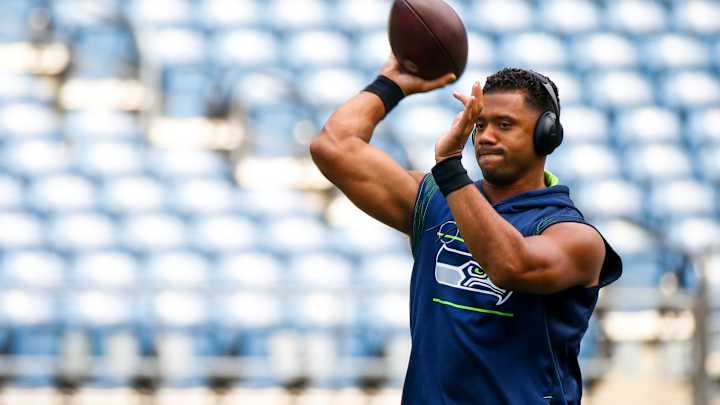Analysis: An Example of Shane Waldron Moving Russell Wilson Out of Pocket

“The Seahawks should move Russell Wilson out of the pocket.”
Statements like this are hardly a new observation, nor are they original desires for Pacific Northwest football. In fact, a quick Twitter search—that app, that bastion of football takes—featuring the terms “Wilson,” “move” and “pocket” throws up some interesting examples.
Behold my masterpiece for my latest @SeahawkMaven pic.twitter.com/uxct6S60c8
— Under Zone X (Frisco)/Phoenix Check/Stick Slasher2 (@mattyfbrown) August 27, 2021
The high demand does make sense. Wilson’s play-style and height, at 5-foot-10, inescapably impact him when trying to access certain windows. Seattle, like any NFL team, sometimes struggles with pass protection. And, with a team that wants to run the football, using run action to move the pocket and a mobile quarterback makes too much sense.
Like with his attempted quick game adjustments, 2020 offensive coordinator Brian Schottenheimer’s movement passes were ultimately unable to overcome the Rams when it mattered: in playoff football. Now steps in Shane Waldron, the schemer-in-chief tasked with working with the elite talent of Russell Wilson. Let’s move on to 2021.
Last week's preseason matchup with the Broncos already showed an exciting movement of the quarterback from the pocket by Waldron. But first; let’s address the advantages and limitations of moving a passer from the pocket.
Moving the quarterback from the pocket like Waldron did—on a sprint out—is less effective than you may have originally believed.
Yes, it floods the defensive coverage with various threats while simplifying the quarterback’s reads and hurting traditional pass rush spacing.
However, this movement shrinks the field in half for the offense while simultaneously reducing the defense’s area to defend.
Therefore, the defense can flood their pass coverage on the play like they would versus a bootleg or naked movement pass.
Moreover, there is no genuine run fake/run action from the offense, so the defense can cheat towards the concept without conflict.
Furthermore, intelligent play-callers can also pick up on indicators, pressuring right into the teeth of the movement and rendering the concept dead on arrival.
There’s a reason that most NFL sprint outs happen in the redzone; coordinators expect man coverage or aggressive matching and one-read plays based around rubs-to-quarterback runs.
What made Waldron’s play intelligent was the design and game situation.
The Seahawks faced a 3rd and 13. They return shifted their tight end from an 11 personnel 3x1 set. The pre-snap movement told them they faced zone coverage, as no player followed the tight end.
To trips formations, the Vic Fangio-led Broncos defense—throughout the game—looked to send bonus fire zone pressure weak.
On this play, Denver ended up sending 6 men at the quarterback—the sixth man adding on weak after the running back stayed in protection.
Seattle, however, executed a full-slide on its offensive line and had its running back pick up the heat backside. Rashaad Penny did an excellent job picking up the most dangerous rusher—the free defender closest to the quarterback. Seattle didn’t need to block the backside edge because he was out of the play by his wide alignment and path.
Not only did this protection work, it was unexpected from a defensive perspective. Typically, teams looking to move from shotgun pockets use the running back as the lead blocker, not as the backside contain pass protector.
Here, the Seahawks instead opted for their tight end as the man to secure the point of attack. Seattle picked up Denver’s pressure and moved its quarterback away from any carnage, providing him with clean sight lines of a passing concept designed to hit near the sticks and pick up the first down—13 yards required.
This is about playing game situations right. With a defense teeing off in the clear passing scenario of 3rd and 13, this is an intelligent offensive method for achieving an unexpected flood pattern that exploits pressure tendencies and beats said pressure. Seven-man, full-slide pass protection with three receiving threats, plus the rolling quarterback, to one side of the field.
Timing- and levels-wise, the out-n-up nature of the comeback route from the No. 1 receiver—like a soft double move—worked nicely as a way to open the zone defense and create levels down the defense. The cornerback was certain that the route would continue vertical. The throw was there.
After all this praise, you’d expect the Seahawks to have picked up a first down on this play. Instead, quarterback Alex McGough lofted a dreadful interception on the concept.
McGough’s release from the team this past week was a foregone conclusion. Thankfully, with Russell Wilson executing similar ideas, defenses will have to be alert for some difficult third-and-long situations in the regular season.
This #Seahawks play is so cool I'm going to have an article on it @SeahawkMaven. Yes, I'm being serious. Yes, it would look nicer with Russell Wilson (that's a theme to the entire preseason offense) pic.twitter.com/65do1ilJ09
— Under Zone X (Frisco)/Phoenix Check/Stick Slasher2 (@mattyfbrown) August 27, 2021

Based and born in the UK, Matty has coached football for over 5 years, including stints as a scout, defensive coordinator, and Wide Receiver/DB Coach. Asides from an Xs and Os obsession, he enjoys: other sports; eating out; plus following Newcastle United. He graduated from the University of East Anglia in 2018 with a BA in Modern History.
Follow @mattyfbrown